2010 MERCEDES-BENZ R320 snow chains
[x] Cancel search: snow chainsPage 18 of 364
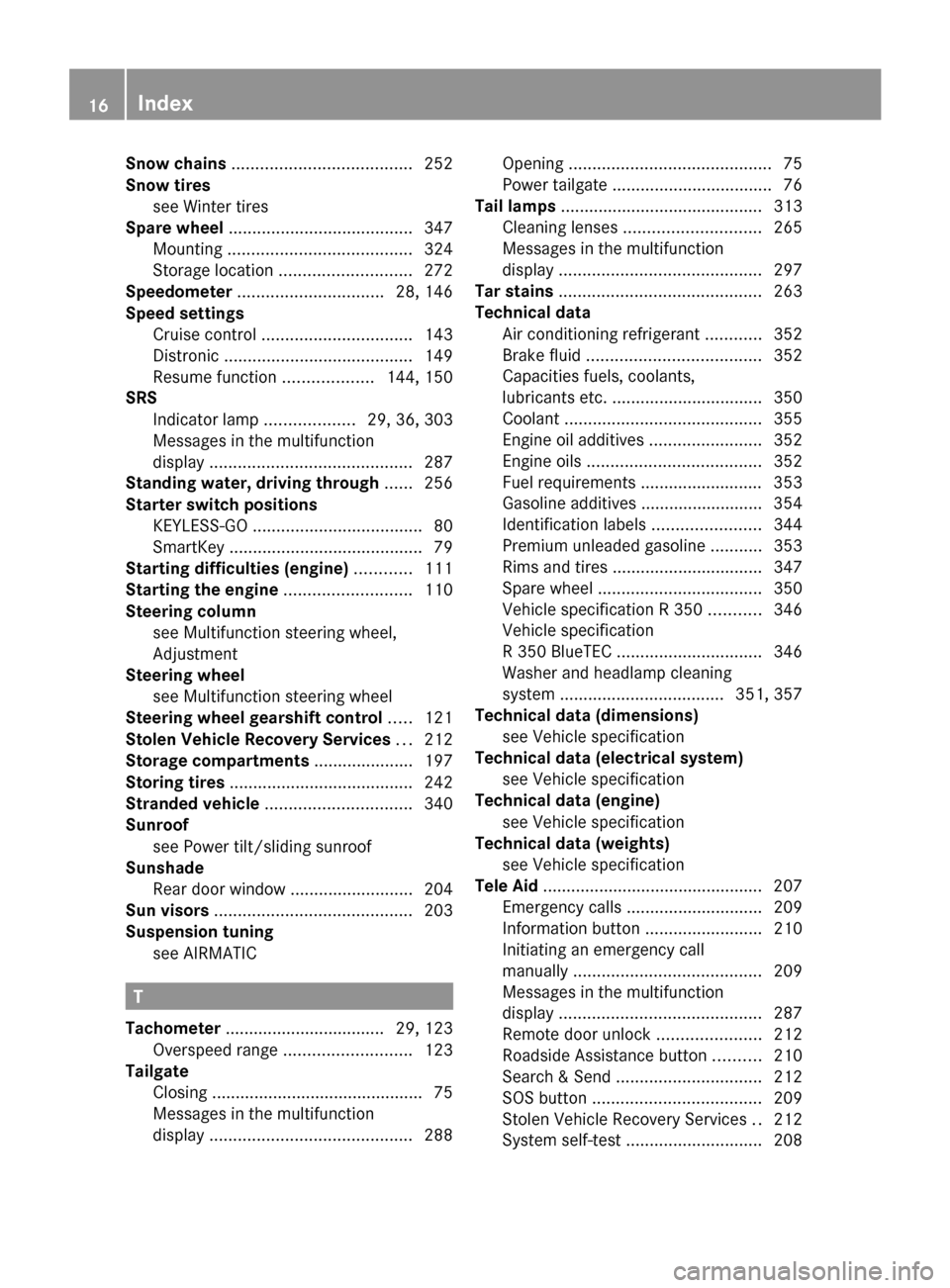
Snow chains
...................................... 252
Snow tires see Winter tires
Spare wheel ....................................... 347
Mounting ....................................... 324
Storage location ............................ 272
Speedometer ............................... 28, 146
Speed settings Cruise control ................................ 143
Distronic ........................................ 149
Resume function ................... 144, 150
SRS
Indicator lamp ................... 29, 36, 303
Messages in the multifunction
display ........................................... 287
Standing water, driving through ......256
Starter switch positions KEYLESS-GO .................................... 80
SmartKey ......................................... 79
Starting difficulties (engine) ............111
Starting the engine ........................... 110
Steering column see Multifunction steering wheel,
Adjustment
Steering wheel
see Multifunction steering wheel
Steering wheel gearshift control .....121
Stolen Vehicle Recovery Services ...212
Storage compartments .....................197
Storing tires ....................................... 242
Stranded vehicle ............................... 340
Sunroof see Power tilt/sliding sunroof
Sunshade
Rear door window ..........................204
Sun visors .......................................... 203
Suspension tuning see AIRMATIC T
Tachometer ..................................
29, 123
Overspeed range ........................... 123
Tailgate
Closing ............................................. 75
Messages in the multifunction
display ........................................... 288Opening ...........................................
75
Power tailgate
.................................. 76
Tail lamps ........................................... 313
Cleaning lenses ............................. 265
Messages in the multifunction
display ........................................... 297
Tar stains ........................................... 263
Technical data Air conditioning refrigerant ............ 352
Brake fluid ..................................... 352
Capacities fuels, coolants,
lubricants etc. ................................ 350
Coolant .......................................... 355
Engine oil additives ........................352
Engine oils ..................................... 352
Fuel requirements .......................... 353
Gasoline additives .......................... 354
Identification labels .......................344
Premium unleaded gasoline ...........353
Rims and tires ................................ 347
Spare wheel ................................... 350
Vehicle specification R 350 ........... 346
Vehicle specification
R 350 BlueTEC ............................... 346
Washer and headlamp cleaning
system ................................... 351, 357
Technical data (dimensions)
see Vehicle specification
Technical data (electrical system)
see Vehicle specification
Technical data (engine)
see Vehicle specification
Technical data (weights)
see Vehicle specification
Tele Aid ............................................... 207
Emergency calls ............................. 209
Information button .........................210
Initiating an emergency call
manually ........................................ 209
Messages in the multifunction
display ........................................... 287
Remote door unlock ...................... 212
Roadside Assistance button .......... 210
Search & Send ............................... 212
SOS button .................................... 209
Stolen Vehicle Recovery Services .. 212
System self-test ............................. 20816
Index 251_AKB; 4; 52, en-US
d2ureepe,
Version: 2.11.8.1 2009-03-23T09:22:52+01:00 - Seite 16
Page 19 of 364

Telephone
............................................. 30
Answering/ending a call ................ 141
Hands-free microphone ...................33
Menu ............................................. 140
Operation ....................................... 140
Phone book .................................... 141
Redialing ........................................ 142
Temperature
Interior temperature ..............168, 176
Outside .................................. 127, 133
Tether anchorage points
see Children in the vehicle
Tie-down rings ................................... 188
Tightening torque Wheels ........................................... 330
Time setting ....................................... 133
TIN (Tire Identification Number) ...... 250
Tire and Loading Information
placard ............................................... 236
Tire and loading terminology ...........248
TIREFIT ............................................... 320
Tire Identification Number see TIN
Tire inflation pressure
Checking ........................................ 230
Important notes on ........................ 229
Label on the inside of fuel filler
flap ................................................ 230
Placard on driver’s door B-pillar ..... 236
Tire labeling ....................................... 244
Tire load rating .................................. 249
Tire ply composition and material
used .................................................... 250
Tire pressure loss warning system . 231
Tire repair kit see TIREFIT
Tires ........................................... 227, 347
Advanced Tire Pressure
Monitoring System (Advanced
TPMS) ............................................ 232
Air pressure ................................... 228
Care and maintenance ................... 241
Cleaning ......................................... 242
Direction of rotation, spinning .......240
Important notes on tire inflation
pressure ........................................ 229
Inflation pressure ........................... 230Information placard .......................
236
Inspection ...................................... 241
Labeling ......................................... 244
Load index ............................. 245, 249
Load rating .................................... 249
Messages in the multifunction
display
................................... 283, 298
MOExtended .................................. 347
Ply composition and material
used ............................................... 250
Problems under-/overinflation ...... 230
Retreads ........................................ 227
Rims and tires (technical data) ...... 347
Rotation ......................................... 243
Service life ..................................... 241
Sizes .............................................. 347
Snow chains .................................. 252
Speed rating .......................... 246, 250
Storing ........................................... 242
Temperature .......................... 229, 243
Terminology ................................... 248
TIREFIT (tire repair kit) ................... 320
Tire Identification Number ............. 250
Tire pressure loss warning system . 231
TPMS low tire pressure/
malfunction telltale ........................ 306
Traction ................................. 242, 250
Tread ............................................. 251
Tread depth ........................... 241, 251
Treadwear ...................................... 242
Treadwear indicators ............. 241, 251
Vehicle maximum load on ..............251
Wear pattern .................................. 243
Winter tires ............................ 251, 347
Tire speed rating .......................246, 250
Tongue Weight Rating see TWR
Top tether
see Children in the vehicle
Total load limit ................................... 250
Towing
Towing eye bolt .............................. 338
Trailer .................................... 119, 256
Vehicle ........................................... 338
Towing eye bolt ................................. 338
Traction ...................................... 242, 250
Trailer towing ............................ 119, 256
Coupling a trailer ........................... 257 Index
17 251_AKB; 4; 52, en-US
d2ureepe,
Version: 2.11.8.1 2009-03-23T09:22:52+01:00 - Seite 17
Page 21 of 364
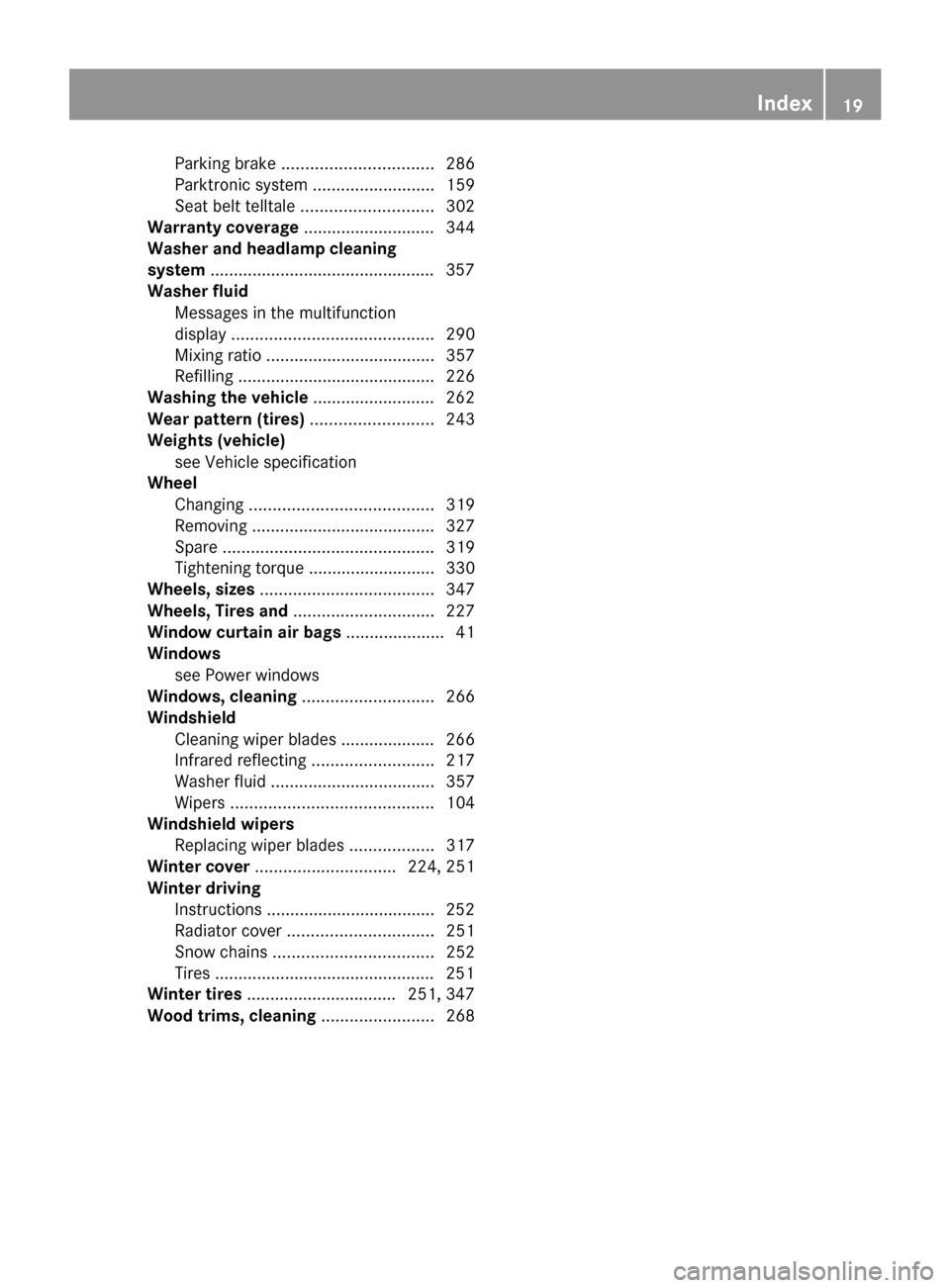
Parking brake ................................
286
Parktronic system ..........................159
Seat belt telltale ............................ 302
Warranty coverage ............................
344
Washer and headlamp cleaning
system ................................................ 357
Washer fluid
Messages in the multifunction
display ........................................... 290
Mixing ratio .................................... 357
Refilling .......................................... 226
Washing the vehicle .......................... 262
Wear pattern (tires) ..........................243
Weights (vehicle) see Vehicle specification
Wheel
Changing ....................................... 319
Removing ....................................... 327
Spare ............................................. 319
Tightening torque ........................... 330
Wheels, sizes ..................................... 347
Wheels, Tires and .............................. 227
Window curtain air bags ..................... 41
Windows see Power windows
Windows, cleaning ............................266
Windshield Cleaning wiper blades .................... 266
Infrared reflecting ..........................217
Washer fluid ................................... 357
Wipers ........................................... 104
Windshield wipers
Replacing wiper blades .................. 317
Winter cover .............................. 224, 251
Winter driving Instructions .................................... 252
Radiator cover ............................... 251
Snow chains .................................. 252
Tires ............................................... 251
Winter tires ................................ 251, 347
Wood trims, cleaning ........................ 268 Index
19 251_AKB; 4; 52, en-US
d2ureepe,
Version: 2.11.8.1 2009-03-23T09:22:52+01:00 - Seite 19
Page 65 of 364
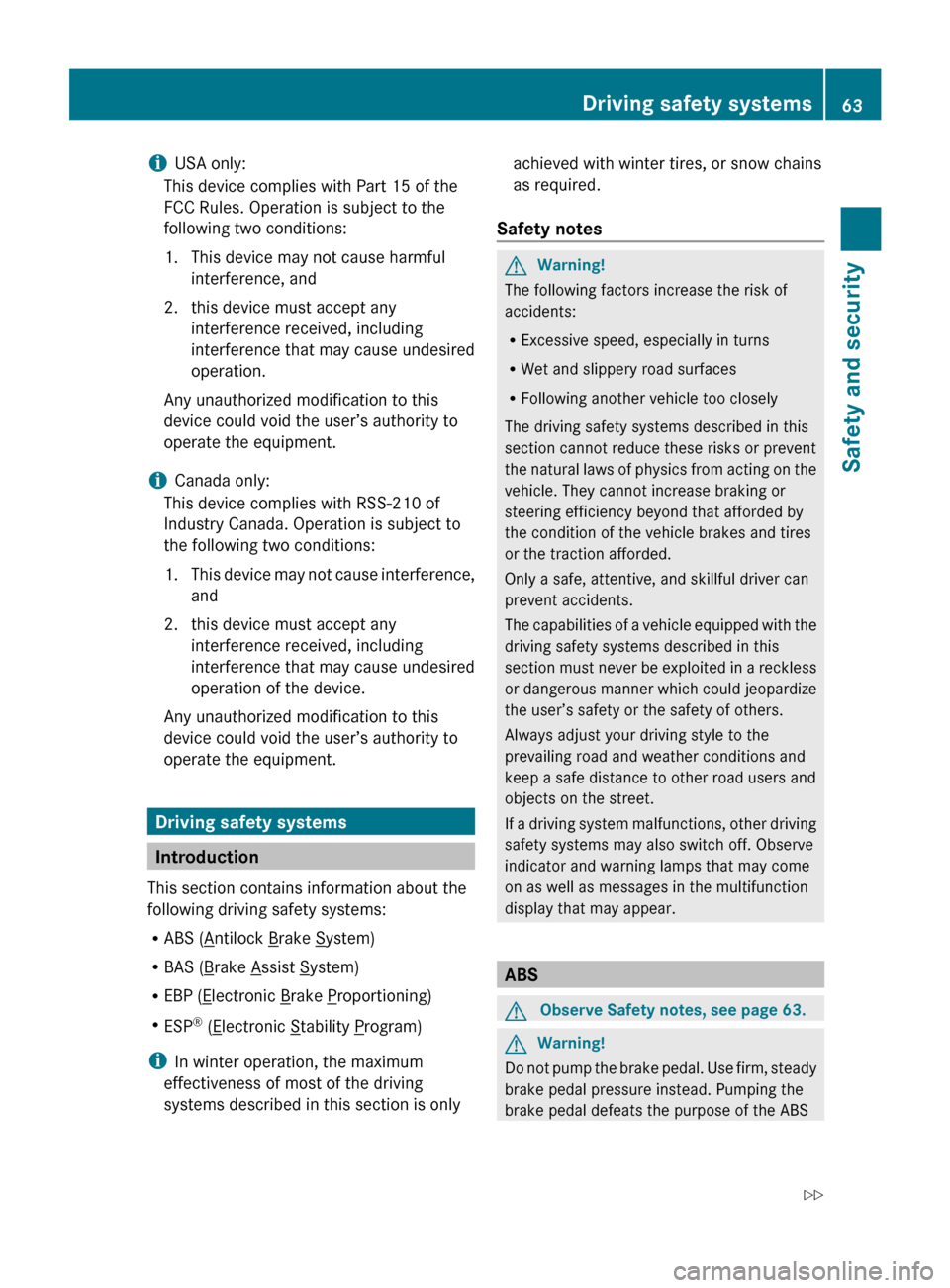
i
USA only:
This device complies with Part 15 of the
FCC Rules. Operation is subject to the
following two conditions:
1.
This device may not cause harmfulinterference, and
2. this device must accept any interference received, including
interference that may cause undesired
operation.
Any unauthorized modification to this
device could void the user’s authority to
operate the equipment.
i Canada only:
This device complies with RSS-210 of
Industry Canada. Operation is subject to
the following two conditions:
1. This device may not cause interference, and
2. this device must accept any interference received, including
interference that may cause undesired
operation of the device.
Any unauthorized modification to this
device could void the user’s authority to
operate the equipment. Driving safety systems
Introduction
This section contains information about the
following driving safety systems:
R ABS ( Antilock Brake System)
R BAS ( Brake Assist System)
R EBP ( Electronic Brake Proportioning)
R ESP ®
( Electronic Stability Program)
i In winter operation, the maximum
effectiveness of most of the driving
systems described in this section is only achieved with winter tires, or snow chains
as required.
Safety notes G
Warning!
The following factors increase the risk of
accidents:
R Excessive speed, especially in turns
R Wet and slippery road surfaces
R Following another vehicle too closely
The driving safety systems described in this
section cannot reduce these risks or prevent
the
natural laws of physics from acting on the
vehicle. They cannot increase braking or
steering efficiency beyond that afforded by
the condition of the vehicle brakes and tires
or the traction afforded.
Only a safe, attentive, and skillful driver can
prevent accidents.
The capabilities of a vehicle equipped with the
driving safety systems described in this
section must never be exploited in a reckless
or dangerous manner which could jeopardize
the user’s safety or the safety of others.
Always adjust your driving style to the
prevailing road and weather conditions and
keep a safe distance to other road users and
objects on the street.
If a driving system malfunctions, other driving
safety systems may also switch off. Observe
indicator and warning lamps that may come
on as well as messages in the multifunction
display that may appear. ABS
G
Observe Safety notes, see page 63. G
Warning!
Do not pump the brake pedal. Use firm, steady
brake pedal pressure instead. Pumping the
brake pedal defeats the purpose of the ABS Driving safety systems
63
Safety and security
251_AKB; 4; 52, en-US
d2ureepe, Version: 2.11.8.1 2009-03-23T09:22:52+01:00 - Seite 63 Z
Page 68 of 364

circumstances described below. Disabling
the system will reduce vehicle stability in
driving maneuvers.
Do not switch off the ESP
®
when a spare
wheel is mounted.
To improve the vehicle’s traction, switch off
the ESP ®
. This allows the drive wheels to spin
and thus cut into surfaces for better grip, for
example
R when driving with snow chains
R in deep snow
R in sand or gravel G
Warning!
Switch on the ESP ®
immediately if the
aforementioned circumstances do not apply
anymore. Otherwise the ESP ®
will not
stabilize the vehicle when it is starting to skid
or a wheel is spinning.
When you switch off the ESP ®
,
R the ESP ®
does not stabilize the vehicle
R the engine output is not limited, which
allows the drive wheels to spin and thus cut
into surfaces for better grip
R the 4-ETS will still apply the brakes to a
spinning wheel
R the ESP ®
continues to operate when you
are braking
R the cruise control or the Distronic system
cannot be activated
R the cruise control or the Distronic system
switch off if activated
i When the ESP ®
is switched off and one or
more drive wheels are spinning, the ESP ®
warning lamp d in the instrument
cluster flashes. However, the ESP ®
will
then not stabilize the vehicle. X
With the engine running, press ESP ®
switch : until the ESP ®
warning lamp
d in the instrument cluster comes on.
The ESP ®
is switched off. G
Warning!
When the ESP ®
warning lamp d is
illuminated continuously, the ESP ®
is
switched off or is not operational due to a
malfunction. Vehicle stability in standard
driving maneuvers is reduced.
Adapt your speed and driving to the prevailing
road conditions and to the non-operating
status of the ESP ®
.
! Avoid spinning of a drive wheel for an
extended period with the ESP ®
switched
off. This may cause serious damage to the
drivetrain which is not covered by the
Mercedes-Benz Limited Warranty.
Switching on the ESP ® X
Press ESP ®
switch : until the ESP ®
warning lamp d in the instrument
cluster goes out.
You are now again in normal driving mode
with the ESP ®
switched on.
ESP ®
trailer stabilization If the trailer you are towing should begin to
sway, the rig can only be stabilized by
immediately applying the brakes hard.
Steering during this maneuver will not help to
stabilize the rig.66
Driving safety systemsSafety and security
251_AKB; 4; 52, en-US
d2ureepe,
Version: 2.11.8.1 2009-03-23T09:22:52+01:00 - Seite 66
Page 158 of 364
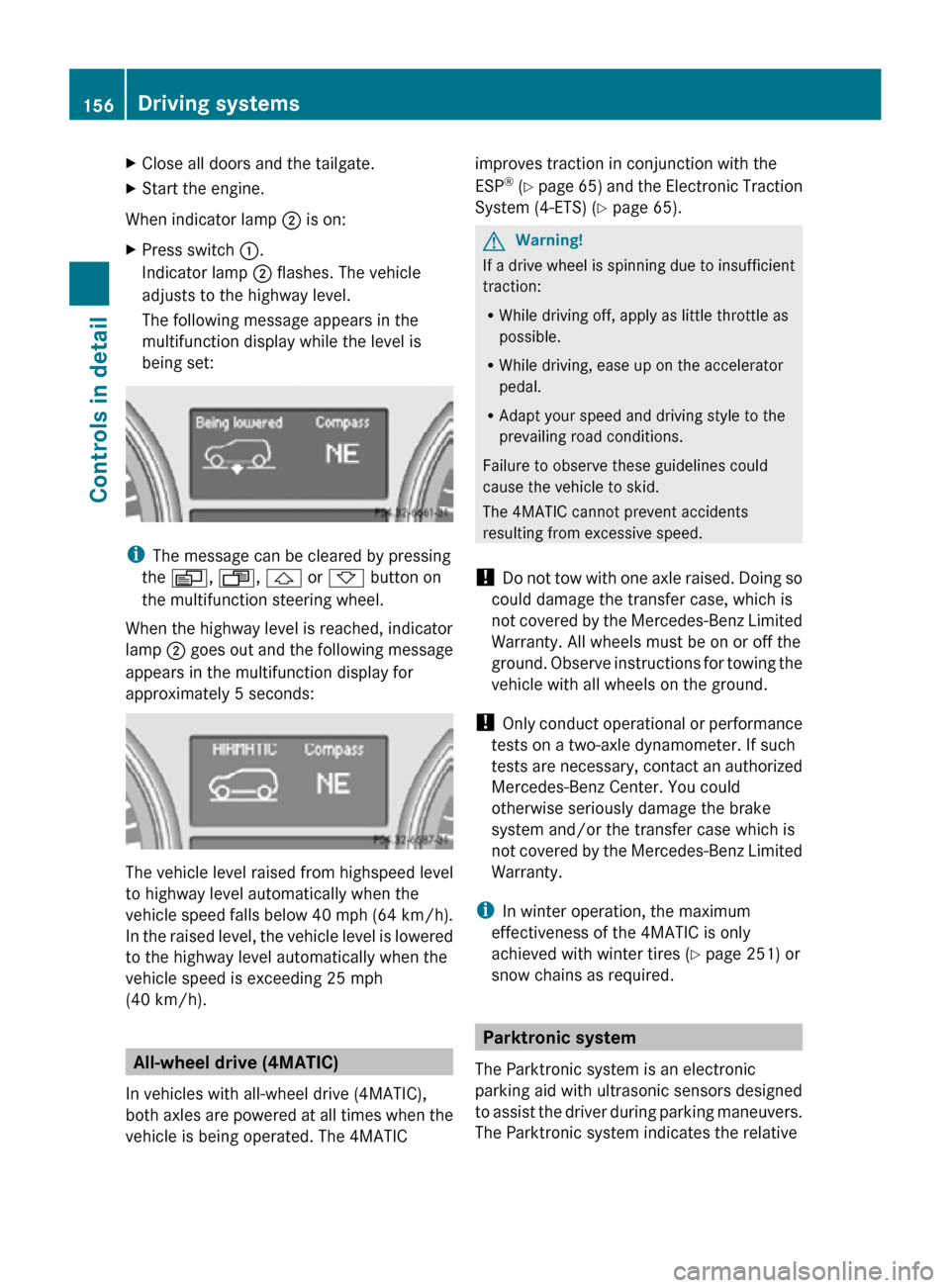
X
Close all doors and the tailgate.
X Start the engine.
When indicator lamp ; is on:
X Press switch :.
Indicator lamp ; flashes. The vehicle
adjusts to the highway level.
The following message appears in the
multifunction display while the level is
being set: i
The message can be cleared by pressing
the V, U, & or * button on
the multifunction steering wheel.
When the highway level is reached, indicator
lamp ; goes out and the following message
appears in the multifunction display for
approximately 5 seconds: The vehicle level raised from highspeed level
to highway level automatically when the
vehicle speed falls below 40 mph (64 km/h).
In the raised level, the vehicle level is lowered
to the highway level automatically when the
vehicle speed is exceeding 25 mph
(40 km/h).
All-wheel drive (4MATIC)
In vehicles with all-wheel drive (4MATIC),
both axles are powered at all times when the
vehicle is being operated. The 4MATIC improves traction in conjunction with the
ESP
®
(Y page 65) and the Electronic Traction
System (4-ETS) (Y page 65). G
Warning!
If a drive wheel is spinning due to insufficient
traction:
R While driving off, apply as little throttle as
possible.
R While driving, ease up on the accelerator
pedal.
R Adapt your speed and driving style to the
prevailing road conditions.
Failure to observe these guidelines could
cause the vehicle to skid.
The 4MATIC cannot prevent accidents
resulting from excessive speed.
! Do not tow with one axle raised. Doing so
could damage the transfer case, which is
not covered by the Mercedes-Benz Limited
Warranty. All wheels must be on or off the
ground. Observe instructions for towing the
vehicle with all wheels on the ground.
! Only conduct operational or performance
tests on a two-axle dynamometer. If such
tests are necessary, contact an authorized
Mercedes-Benz Center. You could
otherwise seriously damage the brake
system and/or the transfer case which is
not covered by the Mercedes-Benz Limited
Warranty.
i In winter operation, the maximum
effectiveness of the 4MATIC is only
achieved with winter tires ( Y page 251) or
snow chains as required. Parktronic system
The Parktronic system is an electronic
parking aid with ultrasonic sensors designed
to assist the driver during parking maneuvers.
The Parktronic system indicates the relative 156
Driving systemsControls in detail
251_AKB; 4; 52, en-US
d2ureepe,
Version: 2.11.8.1 2009-03-23T09:22:52+01:00 - Seite 156
Page 233 of 364
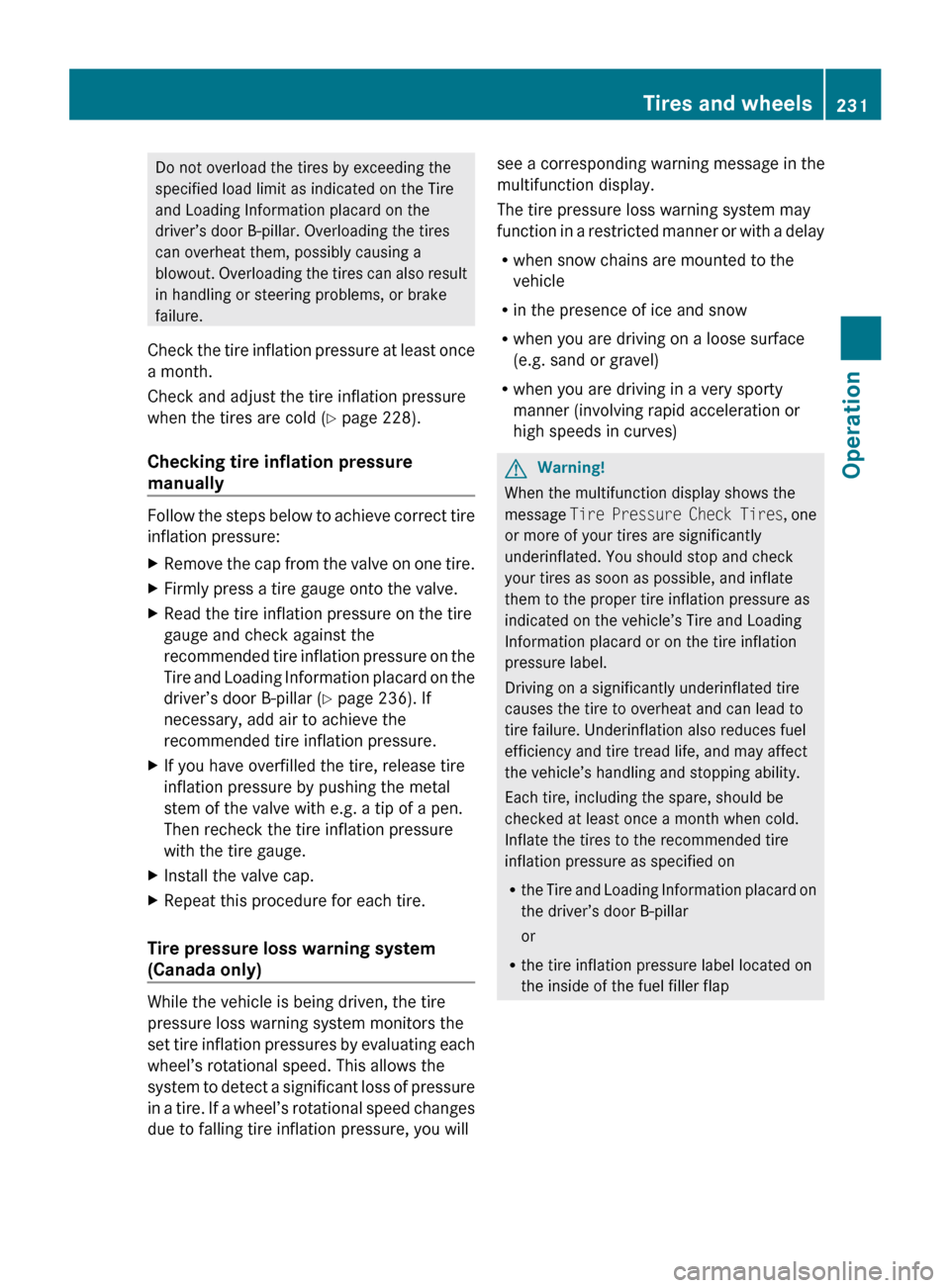
Do not overload the tires by exceeding the
specified load limit as indicated on the Tire
and Loading Information placard on the
driver’s door B-pillar
. Overloading the tires
can overheat them, possibly causing a
blowout. Overloading the tires can also result
in handling or steering problems, or brake
failure.
Check the tire inflation pressure at least once
a month.
Check and adjust the tire inflation pressure
when the tires are cold ( Y page 228).
Checking tire inflation pressure
manually Follow the steps below to achieve correct tire
inflation pressure:
X
Remove the cap from the valve on one tire.
X Firmly press a tire gauge onto the valve.
X Read the tire inflation pressure on the tire
gauge and check against the
recommended
tire inflation pressure on the
Tire and Loading Information placard on the
driver’s door B-pillar ( Y page 236). If
necessary, add air to achieve the
recommended tire inflation pressure.
X If you have overfilled the tire, release tire
inflation pressure by pushing the metal
stem of the valve with e.g. a tip of a pen.
Then recheck the tire inflation pressure
with the tire gauge.
X Install the valve cap.
X Repeat this procedure for each tire.
Tire pressure loss warning system
(Canada only) While the vehicle is being driven, the tire
pressure loss warning system monitors the
set
tire inflation pressures by evaluating each
wheel’s rotational speed. This allows the
system to detect a significant loss of pressure
in a tire. If a wheel’s rotational speed changes
due to falling tire inflation pressure, you will see a corresponding warning message in the
multifunction display.
The tire pressure loss warning system may
function
in a restricted manner or with a delay
R when snow chains are mounted to the
vehicle
R in the presence of ice and snow
R when you are driving on a loose surface
(e.g. sand or gravel)
R when you are driving in a very sporty
manner (involving rapid acceleration or
high speeds in curves) G
Warning!
When the multifunction display shows the
message Tire
Pressure Check Tires , one
or more of your tires are significantly
underinflated. You should stop and check
your tires as soon as possible, and inflate
them to the proper tire inflation pressure as
indicated on the vehicle’s Tire and Loading
Information placard or on the tire inflation
pressure label.
Driving on a significantly underinflated tire
causes the tire to overheat and can lead to
tire failure. Underinflation also reduces fuel
efficiency and tire tread life, and may affect
the vehicle’s handling and stopping ability.
Each tire, including the spare, should be
checked at least once a month when cold.
Inflate the tires to the recommended tire
inflation pressure as specified on
R the Tire and Loading Information placard on
the driver’s door B-pillar
or
R the tire inflation pressure label located on
the inside of the fuel filler flap Tires and wheels
231Operation
251_AKB; 4; 52, en-US
d2ureepe, Version: 2.11.8.1 2009-03-23T09:22:52+01:00 - Seite 231 Z
Page 254 of 364
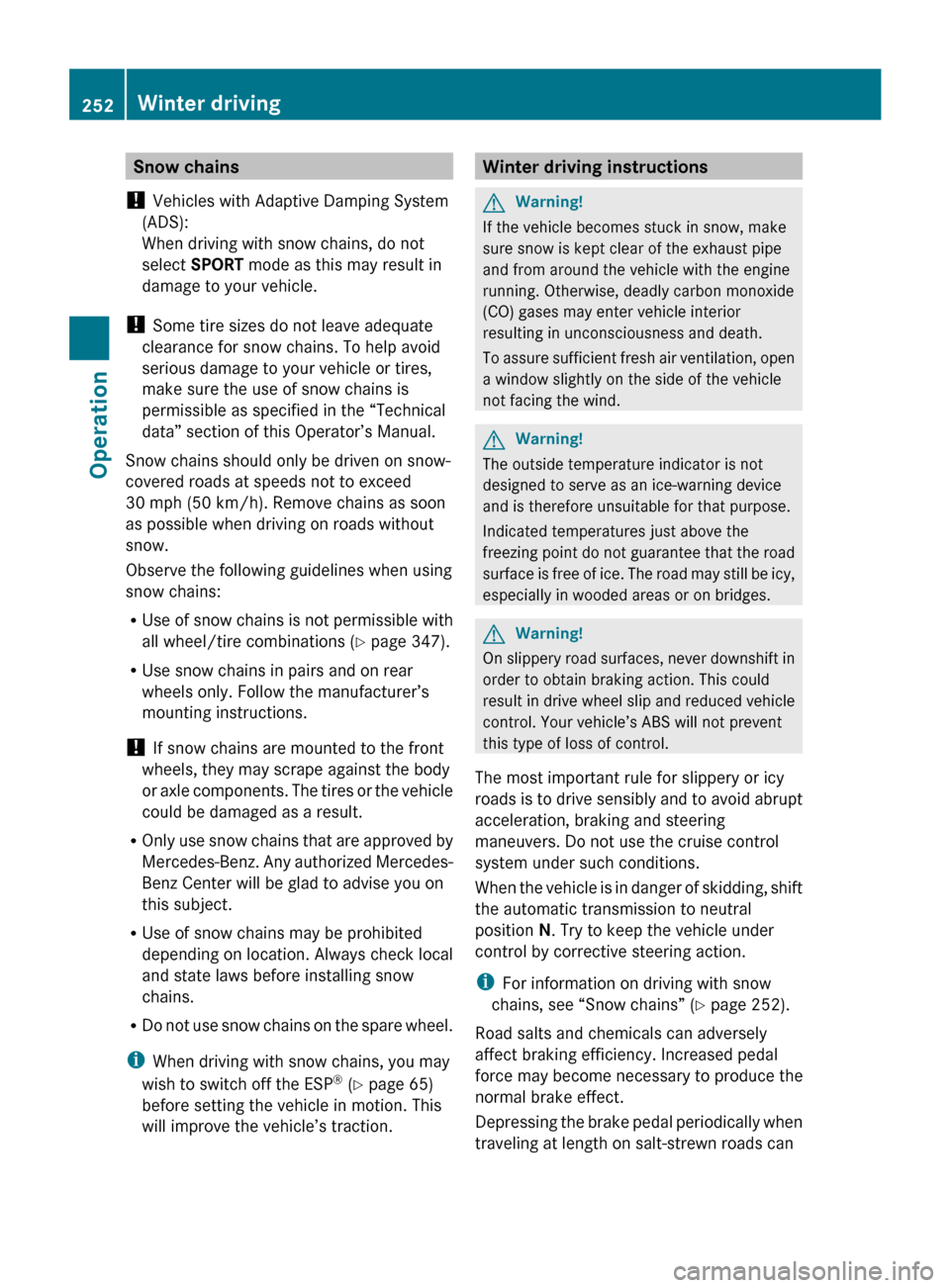
Snow chains
! Vehicles with Adaptive Damping System
(ADS):
When driving with snow chains, do not
select SPORT mode as this may result in
damage to your vehicle.
! Some tire sizes do not leave adequate
clearance for snow chains. To help avoid
serious damage to your vehicle or tires,
make sure the use of snow chains is
permissible as specified in the “Technical
data” section of this Operator’s Manual.
Snow chains should only be driven on snow-
covered roads at speeds not to exceed
30 mph (50 km/h)
. Remove chains as soon
as possible when driving on roads without
snow.
Observe the following guidelines when using
snow chains:
R Use of snow chains is not permissible with
all wheel/tire combinations ( Y page 347).
R Use snow chains in pairs and on rear
wheels only. Follow the manufacturer’s
mounting instructions.
! If snow chains are mounted to the front
wheels, they may scrape against the body
or axle components. The tires or the vehicle
could be damaged as a result.
R Only use snow chains that are approved by
Mercedes-Benz. Any authorized Mercedes-
Benz Center will be glad to advise you on
this subject.
R Use of snow chains may be prohibited
depending on location. Always check local
and state laws before installing snow
chains.
R Do not use snow chains on the spare wheel.
i When driving with snow chains, you may
wish to switch off the ESP ®
(Y page 65)
before setting the vehicle in motion. This
will improve the vehicle’s traction. Winter driving instructions
G
Warning!
If the vehicle becomes stuck in snow, make
sure snow is kept clear of the exhaust pipe
and from around the vehicle with the engine
running. Otherwise, deadly carbon monoxide
(CO) gases may enter vehicle interior
resulting in unconsciousness and death.
To
assure sufficient fresh air ventilation, open
a window slightly on the side of the vehicle
not facing the wind. G
Warning!
The outside temperature indicator is not
designed to serve as an ice-warning device
and is therefore unsuitable for that purpose.
Indicated temperatures just above the
freezing
point do not guarantee that the road
surface is free of ice. The road may still be icy,
especially in wooded areas or on bridges. G
Warning!
On slippery road surfaces, never downshift in
order to obtain braking action. This could
result
in drive wheel slip and reduced vehicle
control. Your vehicle’s ABS will not prevent
this type of loss of control.
The most important rule for slippery or icy
roads is to drive sensibly and to avoid abrupt
acceleration, braking and steering
maneuvers. Do not use the cruise control
system under such conditions.
When the vehicle is in danger of skidding, shift
the automatic transmission to neutral
position N. Try to keep the vehicle under
control by corrective steering action.
i For information on driving with snow
chains, see “Snow chains” ( Y page 252).
Road salts and chemicals can adversely
affect braking efficiency. Increased pedal
force may become necessary to produce the
normal brake effect.
Depressing the brake pedal periodically when
traveling at length on salt-strewn roads can 252
Winter driving
Operation
251_AKB; 4; 52, en-US
d2ureepe,
Version: 2.11.8.1 2009-03-23T09:22:52+01:00 - Seite 252